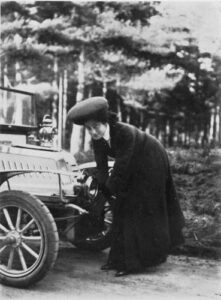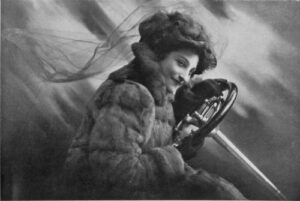by James Scott Bell
@jamesscottbell
I love Project Gutenberg. This site has an ongoing project of digitizing works from the past that have fallen into public domain. The works are then made available—for free download—in Kindle, Epub, or text format. You can also read the books online. There are many classics of world literature available, but it’s the small, quirky, period books I find most interesting. If you write historical fiction, Project Gutenberg offers a treasure trove of research material from the 1700s on.
Via Feedly, I get an alert on their latest digitized titles. Many of them don’t interest me, i.e., titles like The Fern Lover’s Companion: A Guide for the Northeastern States and Canada and A Treatise on the Origin, Progress, Prevention, and Cure of Dry Rot in Timber.
But every now and then a title catches my eye and I go in for a peek at the text. The other day it was The Woman and the Car, published in 1909, and described as “A chatty little handbook for all women who motor or who want to motor.”
Having written about that period, I gave the book a peruse. It has a chapter on proper dress, filled with details that could be used to great effect in a novel.
 In another chapter, it gives specific instructions on how to start a car:
In another chapter, it gives specific instructions on how to start a car:
In front of the car you will notice a handle. Push it inwards until you feel it fit into a notch, then pull it up sharply, releasing your hold of the handle the moment you feel you have pulled it over the resisting (compression) point. Unless starting a car fitted with magneto ignition, on no account press down the handle—always pull it upwards, smartly and sharply. If it is pressed down the possibility of a backfire is greater—and a broken arm may result.
Then there’s a chapter on “Motor Manners.” Some of the rules of courteous driving behavior are worthy of note:
-
If the road is wet, give pedestrians and cyclists a wide berth so as not to splash them with mud.
-
Avoid the bad and perilous habit of trying to squeeze through doubtful openings in traffic.
-
Remember, however, that it is necessary to sound the hooter when coming up behind and intending to pass a pedestrian or a vehicle…A hooter is meant to give warning, not to startle people.
It occurred to me that we writers owe our readers some common courtesy, too:
- Pull the handle sharply and smartly to start your story
If you don’t hear the motor, check that your handle is fit into the notch (that is, connected to a character) and that you have pulled vigorously enough to cause combustion (a scene with something disturbance).
- Do not splash the reader with mud
Gratuitous profanity is mud, in the opinion of this driver.
- Do not bore the reader by trying to squeeze too much information into a doubtful opening
It’s almost always best to withhold as much exposition as you can for as long as you can. It creates a sense of mystery, giving readers an invisible prompt to keep turning pages. I just finished re-reading The Maltese Falcon and noted that the background information about the black bird does not come until the middle of the novel.
- Don’t annoy potential readers with your, um, horn
While the occasional tooting of your own horn is acceptable on social media, too much of that kind of noise is a turn off.
What other tips you can think of for the well-mannered writer?
***
And in honor of Father’s Day, spend a couple of minutes with the legendary Groucho Marx as he sings a famous ditty for dads.

